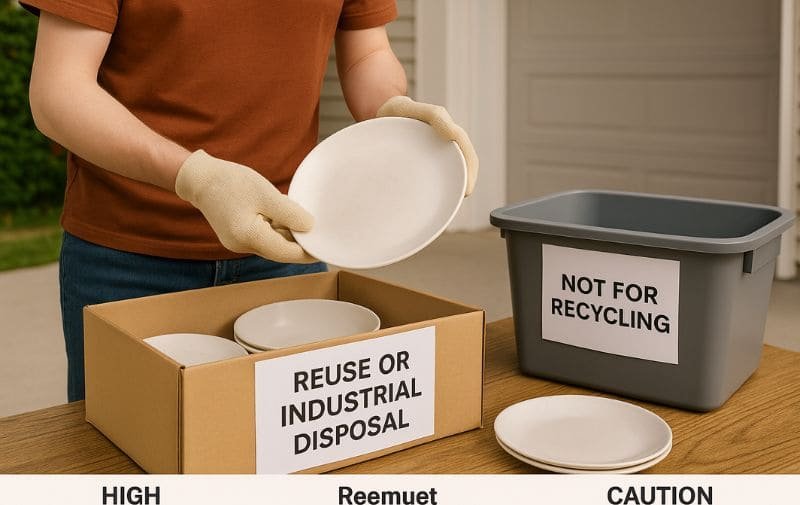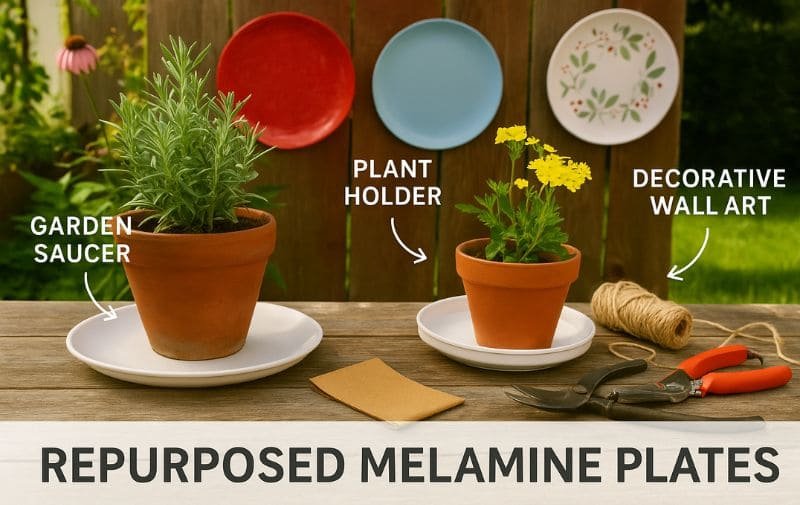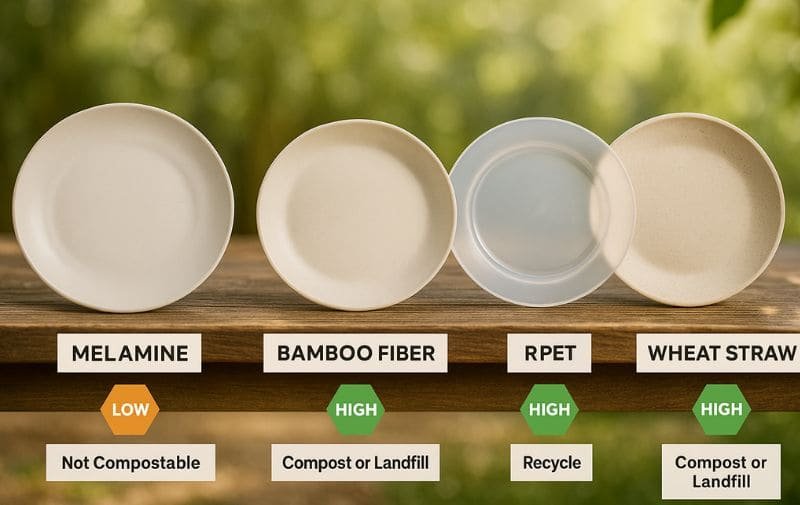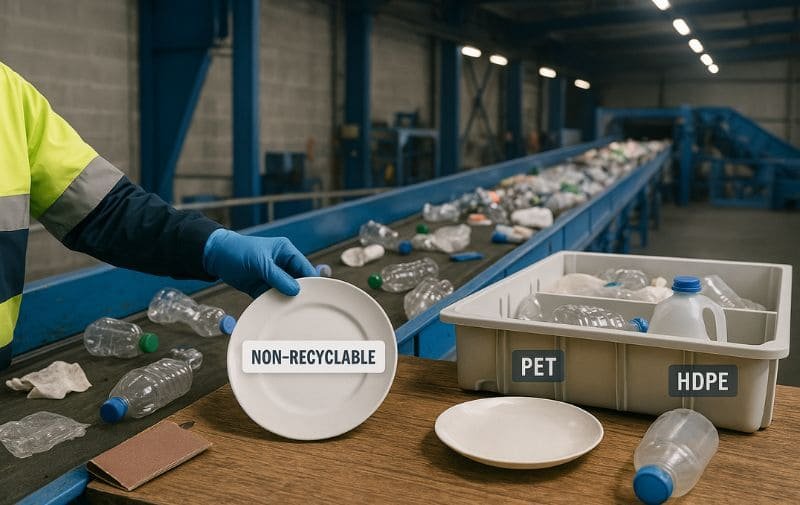You’re cleaning out your kitchen cabinets and find some old, scratched melamine plates. You want to do the right thing, but you’re not sure what that is. Does this go in the trash, or can it go in the blue recycling bin with the plastic bottles?
No, melamine plates are not recyclable through your local curbside recycling program. Melamine is a thermosetting plastic, meaning it cannot be re-melted and reformed like other plastics, so it must be disposed of in your regular household trash.
That’s the short, practical answer every homeowner and restaurant manager needs. But it opens up a much bigger, more important question: If it’s not recyclable, can melamine still be considered a sustainable or eco-friendly choice? The answer is a surprising “yes,” but to understand why, you have to look past the recycling symbol and think about the entire lifecycle of a product. In this guide, we’ll break down the science, the proper disposal methods, and why durability might be the most powerful form of sustainability there is.
Last Updated: Sep 8th 2025 | Estimated Reading Time: 9 Minutes

The Simple Answer vs. The Complicated Truth
Let’s start with the most direct answer you need. For you as a consumer, restaurant owner, or cafeteria manager, the answer is an emphatic NO.
YoFor you, the end-user, the answer is an emphatic “no.” You cannot put melamine plates in your municipal recycling bin. Putting them there is an act of “wish-cycling”—hoping something is recyclable when it isn’t—which actually harms the recycling process.
Melamine is a #7 plastic, which is a catch-all category for “other” plastics. It contaminates the recycling stream because its chemical makeup prevents it from being melted and recycled with common plastics like PET (#1) and HDPE (#2).
Imagine your old melamine plate arriving at your local recycling facility. It travels down a conveyor belt where magnets pull out steel and optical scanners identify and sort plastic bottles. The system doesn’t recognize the melamine plate. A human sorter, who has just seconds to make a decision, sees a hard, heavy object that looks more like ceramic.
They will pull it off the line and toss it into the landfill pile. Best case, it wastes time and energy. Worst case, it ends up in a bale of valuable PET plastic, contaminating the entire batch and potentially causing the whole thing to be rejected and sent to the landfill.
The Chemical Handcuffs: Why Melamine Can’t Be Re-Melted?
To understand why melamine is non-recyclable, you need to know about the two fundamental types of plastic. The difference between them is everything.
Melamine is a thermosetting plastic, which means that during manufacturing, its molecules form permanent, irreversible chemical bonds. Unlike thermoplastics, it cannot be melted back down into a liquid to be reformed.
The easiest way to think about this is the “Ice Cube vs. The Cookie” analogy.
| Plastic Type | The Analogy | Explanation | Examples | Is it Recyclable? |
|---|---|---|---|---|
| Thermoplastic | An Ice Cube | You can melt an ice cube into water and then re-freeze it back into an ice cube. Its chemical structure doesn’t change. It can be re-melted and reformed many times. | PET water bottles (#1), HDPE milk jugs (#2), PVC pipes (#3) | Yes |
| Thermosetting Plastic | A Cookie | You mix dough, bake it, and a permanent chemical change occurs. You can’t melt a cookie back into raw dough. You can only smash it into crumbs. | Melamine, Bakelite, Epoxy Resin, Silicone | No |
The very properties that make melamine so strong, durable, and heat-resistant are its “chemical handcuffs.” The irreversible bonds created during the high-heat molding process are what lock in its shape and strength forever.

So, Where Do Old Melamine Plates Go?
If they can’t be recycled, what is the right way to dispose of old melamine dinnerware?
For post-consumer melamine plates, the only correct disposal method is the standard household trash, which goes to a landfill. However, before you toss them, consider if they can be donated or upcycled.
- First Choice: Upcycle or Donate. If the plates are still in good, usable condition (not heavily chipped or scratched), consider donating them to a local thrift store. Alternatively, get creative! Use them as saucers for potted plants, as paint palettes for crafting, or break them up to use as drainage in the bottom of large planters.
- Last Resort: The Trash. If the plates are broken, heavily scratched, or otherwise unusable, the trash is the correct place for them. Do not feel guilty about this—placing them in recycling would be the wrong choice.
You may have read that industrial melamine scrap can be ground into a powder and used as a filler. While this is true, it is almost exclusively done with pre-consumer waste—clean scrap from the factory floor. The logistics of collecting, sanitizing, and processing millions of used, post-consumer plates from countless homes and restaurants make this type of “downcycling” economically and practically impossible.
The Reframe: Is Durability a Higher Form of Sustainability?
This brings us to the core of the debate. Our culture is so focused on the “recyclable” symbol that we’ve forgotten a more powerful and intuitive form of sustainability: extreme longevity.
The most sustainable product is the one you don’t have to replace. By creating far less waste over its long lifespan, a durable melamine plate is often a more environmentally responsible choice than a fragile ceramic plate or a single-use paper plate.
Think about the total waste created over a 10-year period in a busy family kitchen or restaurant.
Lifecycle Waste Comparison (Hypothetical 10-Year Span)
| Dinnerware Type | Average Lifespan (Heavy Use) | Replacements Needed in 10 Years | Total Plates Sent to Landfill | The Big Picture |
|---|---|---|---|---|
| High-Quality Melamine Plate | 5-10+ years | 0-1 | 1-2 | One plate serves thousands of meals. Very low waste stream. |
| Standard Ceramic Plate | 6 months – 2 years | 5-20 | 6-21 | Constant breakage creates a steady stream of non-recyclable ceramic waste heading to the landfill. |
| Disposable Paper Plate | 10 minutes | Thousands | Massive Volume | Requires constant resources (trees, water, energy) for production and creates a mountain of landfill waste. |
When you look at it this way, the melamine plate, which prevents the waste of dozens of broken ceramic plates or thousands of paper plates, suddenly looks like a very eco-friendly option. Its sustainability comes from waste prevention, not end-of-life processing. environmentally responsible choice, even if it isn’t recyclable at the end of its very long life.
What About “Eco-Friendly” Bamboo or Wheat Straw Melamine?
You may have seen newer plates on the market that are a composite of melamine and natural fibers like bamboo, rice husks, or wheat straw. Are these a more sustainable breakthrough?
These composite materials are a step forward in sustainability, but not because they are recyclable or biodegradable. Their environmental benefit comes at the start of the product’s life, by reducing the amount of virgin plastic resin needed to make the plate.
By using natural, renewable fibers as a filler, top-tier manufacturers can reduce the amount of pure melamine resin in a plate by 30-40%. This lowers the carbon footprint of production. However, it’s crucial to understand what these plates are not:
- They are NOT biodegradable. The melamine resin still binds everything together in a non-biodegradable matrix.
- They are NOT recyclable. They are still a thermoset plastic and cannot be re-melted.
Be wary of any “greenwashing” that claims these products will break down in a landfill. Their primary green credential is the reduced use of fossil fuel-based resins at the point of creation.

For Businesses: The Smart, Sustainable Investment
For restaurant owners, choosing dinnerware isn’t just about looks; it’s a critical financial and operational decision.
Choosing durable melamine dinnerware drastically reduces a restaurant’s operational waste stream and lowers the Total Cost of Ownership (TCO) by minimizing constant replacement costs associated with breakable wares.
When a ceramic plate breaks, you lose more than the plate. You lose the cost of the food on it, the labor to clean it up, the potential for guest or staff injury, and the cost of replacement. Melamine virtually eliminates these costs. This allows you to communicate your sustainable choice to customers not just from an “eco” perspective, but from a “smart business” perspective that focuses on reducing waste and maximizing resource efficiency.
Conclusion
While melamine plates are not recyclable in your blue bin, they represent a different, powerful kind of sustainability. Their value lies not in their end-of-life options, but in their exceptionally long and durable life, which prevents a massive amount of waste from ever being created in the first place..
Frequently Asked Questions (F.A.Q.)
1. What is the most eco-friendly type of dinnerware?
There is no single “most eco-friendly” material; it depends on your priorities. For minimizing waste through durability, high-quality melamine and laminated glass (Corelle) are top choices. For natural materials, items like slate or acacia wood (with proper care) can be sustainable. The least eco-friendly options are always single-use disposables.
2. Is melamine better for the environment than ceramic?
It’s a trade-off. Ceramic production can be energy-intensive, and its fragility in high-use settings leads to significant landfill waste. Melamine’s production uses fossil fuels, but its extreme durability drastically reduces waste over its lifespan. For a busy restaurant or family, melamine often has a lower overall environmental footprint due to waste reduction.
3. Are bamboo-melamine plates biodegradable?
No. This is a common greenwashing misconception. The melamine resin used to bind the bamboo fibers is a plastic that does not biodegrade. These composite plates are just as non-recyclable and non-biodegradable as 100% melamine plates.
4. What should I do with old melamine plates that are still in good condition?
Donate them! Local thrift stores, shelters, or community centers are often happy to accept durable, reusable dinnerware. Giving your plates a second life is the most sustainable option of all.
5. How do I know if a plastic is recyclable?
Focus on the shape, not just the number. Residential recycling programs are primarily set up to handle plastic bottles, jugs, and tubs. Hard, rigid plastic items like plates, toys, or storage bins are generally not accepted, regardless of the number on them. Always check your local municipality’s specific guidelines.
6. Does the energy saved by not replacing broken plates offset the energy used to make melamine?
Lifecycle analysis (LCA) studies are complex, but in many commercial scenarios, the answer is yes. The energy, water, and raw materials required to constantly manufacture, package, and ship replacement ceramic plates—plus the environmental cost of landfilling the broken pieces—can quickly exceed the one-time energy cost of producing a single, long-lasting melamine plate.
Recommended:
EPA – Plastics: Material-Specific Data
Wikipedia – Thermosetting Polymer
The Association of Plastic Recyclers (APR) – Plastic Recycling Terms & Definitions


